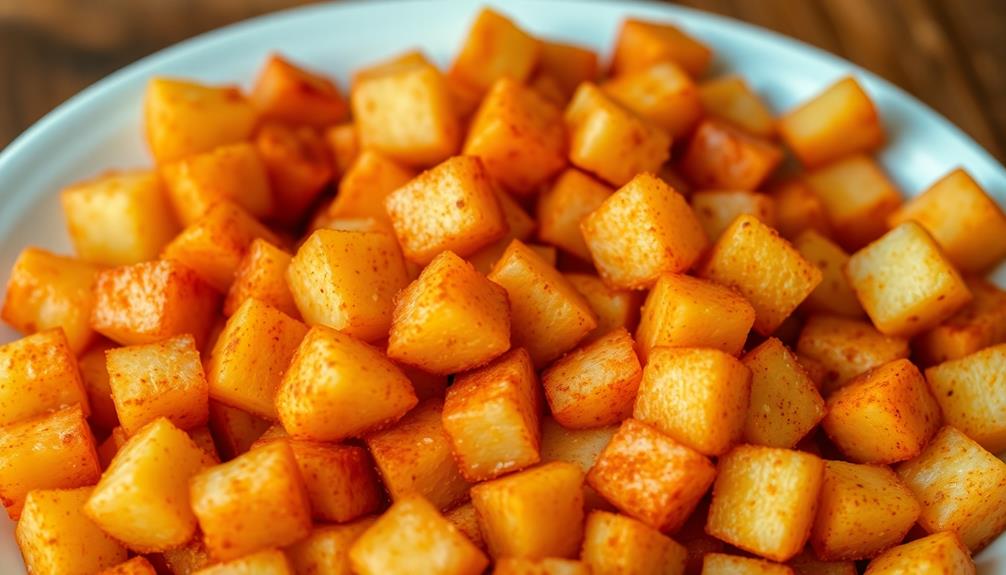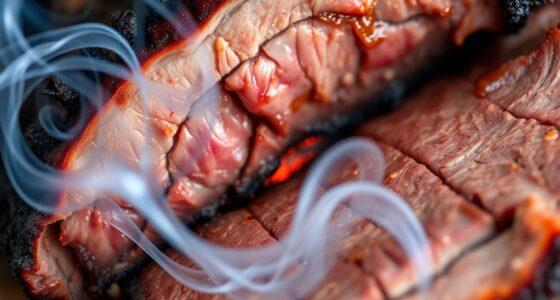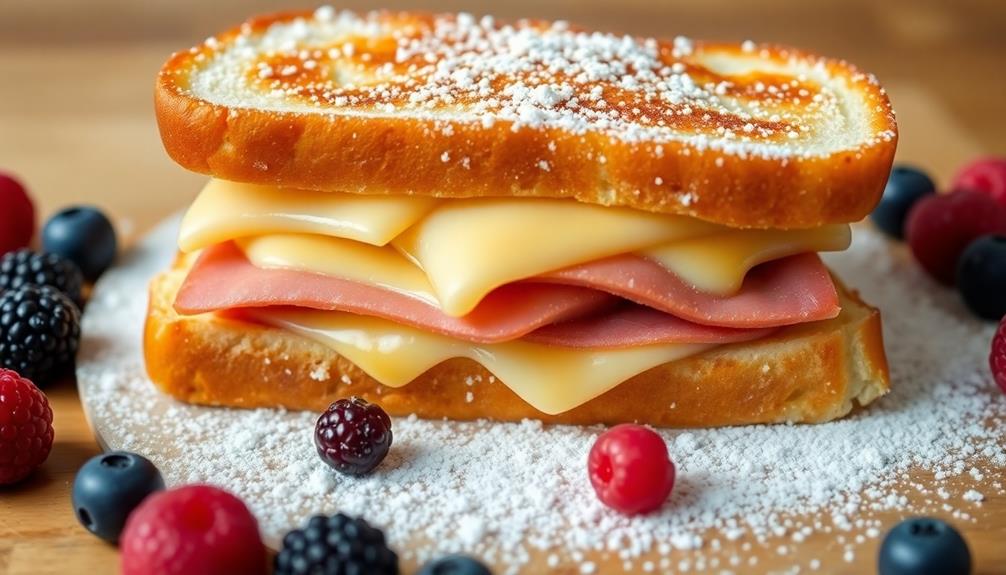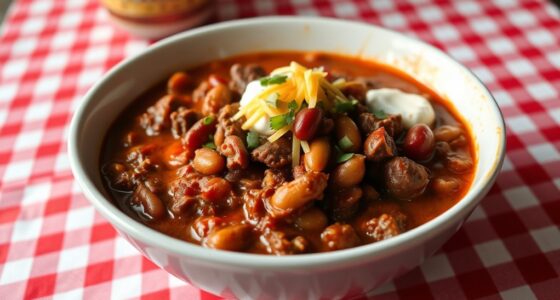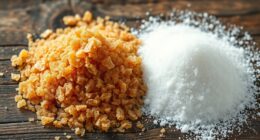Home fries are a beloved breakfast dish that'll have your taste buds jumping for joy! They started way back when early American settlers would fry up potatoes over open flames. Today, you can whip up your own crispy home fries by dicing up some spuds, soaking them in cold water, and then sautéing them to perfection in oil. Be sure to season them with salt, pepper, and other tasty spices. The key is getting that amazing golden-brown crust – it's the secret to truly mouthwatering home fries. Keep reading to discover the complete step-by-step process for making these breakfast classics.
Key Takeaways
- Home fries have their origins in the early American settlers who fried potatoes as a hearty dish over open flames.
- The recipe for home fries evolved over time, with the addition of onions, peppers, and seasonings like paprika and garlic powder.
- Preparing home fries involves dicing potatoes, soaking them in water to remove excess starch, and then sautéing them in oil until crispy.
- Seasoning the potatoes with salt, pepper, and other spices during the cooking process enhances the flavor and texture of home fries.
- Home fries are a beloved breakfast staple, often served with eggs and bacon, and can be garnished with various toppings to suit individual preferences.
History
The origins of home fries can be traced back to the early American settlers, who often fried potatoes as a simple, hearty dish. These pioneers would slice or dice the potatoes, then fry them in their cast-iron skillets over an open flame. It was a delicious and filling meal that helped fuel their hard work on the frontier.
Over time, the recipe for home fries evolved. Cooks started adding onions, peppers, or other veggies to the mix, creating a more flavorful dish. Some even experimented with seasonings like paprika or garlic powder.
By the late 19th century, home fries had become a beloved staple in many American households, a comforting taste of the country's pioneering spirit.
Today, home fries remain a breakfast favorite, whether served alongside eggs and bacon or as a tasty side dish. Their simple, rustic roots continue to inspire home cooks, who find joy in recreating this timeless classic in their own kitchens.
Cooking Steps
Preparing home fries is a straightforward process that requires a few simple steps. First, you'll need to dice some potatoes into small, bite-sized cubes. Don't worry if they're not perfectly uniform – the irregular shapes will add character to your dish!
Next, heat up a skillet or cast-iron pan over medium-high heat and add a bit of oil or butter. Once the oil is shimmering, carefully add your potato cubes and let them sizzle. Be patient and resist the urge to stir too often, as this will help the potatoes develop a delightful crunch on the outside.
After a few minutes, give the potatoes a gentle toss and continue cooking until they're tender on the inside and golden brown on the outside.
Season with a sprinkle of salt, pepper, or any other spices you enjoy. Serve hot, garnished with chopped onions, bell peppers, or a sprinkle of fresh parsley for a pop of color and flavor. Enjoy your homemade home fries!
Step 1. Scrub and Dice Potatoes
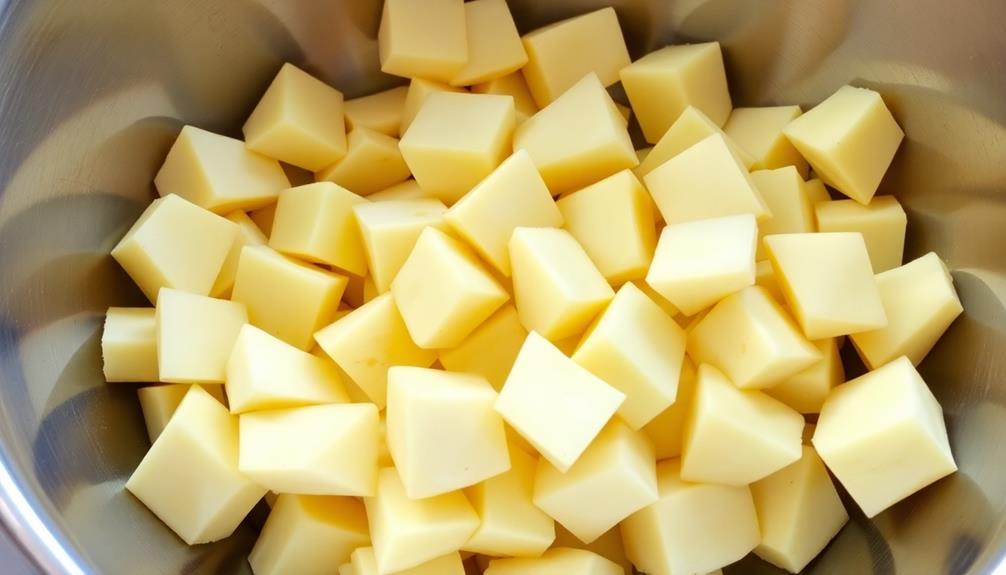
Wash the potatoes thoroughly under cool running water, scrubbing the skins with a vegetable brush to remove any dirt or impurities.
Grab a sharp knife and carefully cut the potatoes into small, even cubes. Aim for pieces about the size of a nickel or a dime – this will help them cook evenly. As you dice, make sure to discard any blemished or discolored areas.
Once all the potatoes are neatly cubed, give them a good rinse under water to wash away any excess starch. Drain the potatoes well, either in a colander or by patting them dry with paper towels.
You want them as dry as possible before cooking, so they'll get nice and crispy. With the hard work done, you're now ready to move on to the next step in creating your delicious home fries!
Step 2. Soak Diced Potatoes in Cold Water
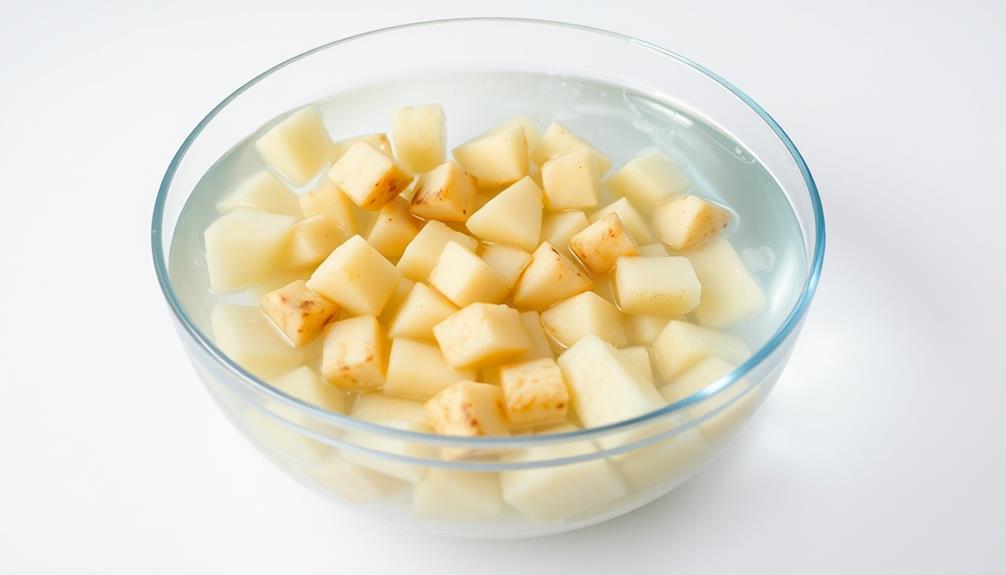
Soaking the diced potatoes in cold water is a crucial step that helps remove excess starch and prevents them from browning too quickly during cooking. This simple process ensures your home fries turn out crispy on the outside and fluffy on the inside.
After carefully scrubbing and dicing your potatoes, place them in a large bowl or pot and cover with cold water. Let them soak for at least 30 minutes, or up to a few hours if you have the time. This helps draw out the excess starch, which can make the potatoes gummy or soggy when cooked.
Drain the potatoes thoroughly and pat them dry with paper towels or a clean kitchen towel. The drier the potatoes, the crispier they'll get when you fry them up.
Now you're ready to move on to the next step – heating up the oil and getting those home fries sizzling to perfection!
Step 3. Drain and Pat Potatoes Dry
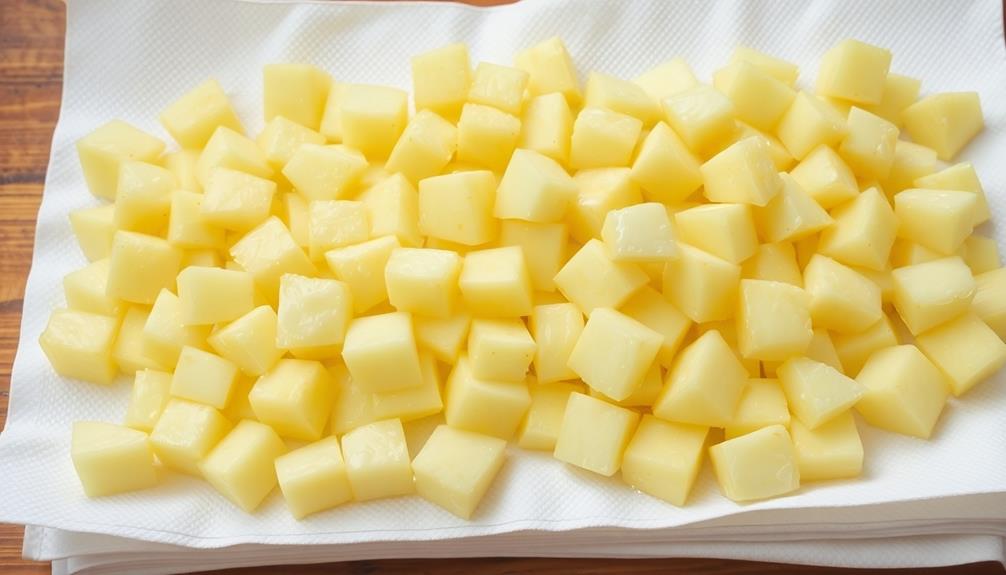
After letting the diced potatoes soak, go ahead and drain them thoroughly in a colander or mesh strainer.
You'll want to make sure to get rid of as much of that water as possible. Give the potatoes a few good shakes to remove any excess liquid.
Then, grab a clean kitchen towel or some paper towels and gently pat the potatoes dry. This extra step is important because you don't want any water clinging to the potatoes when they hit the hot oil.
Wet potatoes will make the oil splatter and cool down the temperature, leading to soggy, greasy home fries.
By taking the time to drain and dry the potatoes, you'll end up with crispy, golden-brown home fries that are perfectly cooked through.
Keep going, and you'll be well on your way to mastering this classic side dish!
Step 4. Sauté Diced Potatoes in Oil
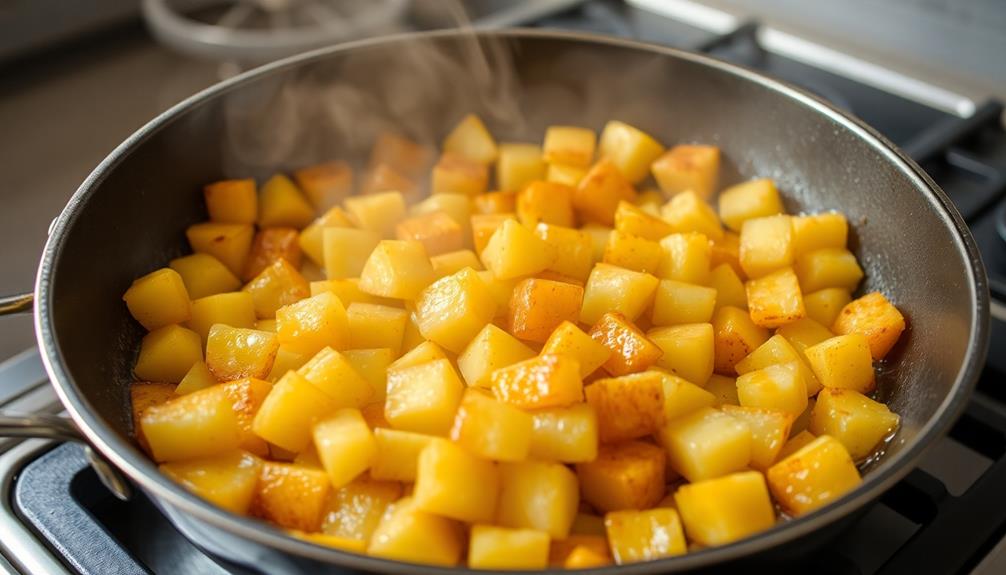
With the potatoes thoroughly dried, it's time to start cooking them. In a large skillet, heat about 2 tablespoons of vegetable oil over medium-high heat.
Once the oil is shimmering, carefully add the diced potatoes in an even layer. You'll want to let them sizzle and brown on one side before stirring, which should take 2-3 minutes.
Next, use a spatula to flip and toss the potatoes so they cook evenly on all sides. Continue sautéing for 5-7 more minutes, stirring occasionally, until the potatoes are tender and golden brown.
Be patient – you want them to get nice and crispy!
As the potatoes cook, you can season them with a sprinkle of salt, pepper, garlic powder, or any other spices you enjoy.
The key is to let them sizzle and get crispy, which will give you those irresistible home fry flavors. Keep a close eye to prevent burning, and you'll have perfectly sautéed diced potatoes in no time!
Step 5. Season With Spices

As the potatoes sizzle in the skillet, now is the time to season them with your desired spices. This is where you can get creative and make the home fries your own! Start with a sprinkle of salt and pepper to bring out the natural flavors.
You can also try garlic powder, onion powder, paprika, or even a dash of cayenne for a little kick.
Don't be afraid to experiment with different herb and spice combinations. Try Italian seasoning for a savory twist or chili powder and cumin for a Tex-Mex vibe. The key is to add the spices a little at a time, tasting as you go, until you achieve the perfect blend of flavors.
Once you've seasoned the potatoes to your liking, give the skillet a gentle stir to evenly distribute the spices. Let the home fries continue to sizzle, allowing the flavors to meld together and create a delicious crust on the outside of the potatoes.
Final Thoughts
Home fries deserve a place on every breakfast plate. They're a classic comfort food that's easy to make and so satisfying. When you've got that perfect golden-brown crust and fluffy interior, it's pure breakfast bliss.
Now that you've mastered seasoning your home fries, it's time to get them on the table. Serve them up hot, fresh, and piping with your favorite breakfast items. They pair wonderfully with eggs, bacon, sausage, or even pancakes. If you’re feeling adventurous, you can even use them as a base for a breakfast skillet or breakfast burrito. If you’re in the mood for a classic fast food combo, serve them up with some scrambled eggs and a side of crispy bacon. Alternatively, if you’re looking for a lighter option, they also complement a fresh fruit salad perfectly.
And don't forget to top them with a sprinkle of cheese, a dollop of ketchup, or a dash of hot sauce if that's your thing.
No matter how you enjoy them, home fries are a breakfast staple that are sure to please the whole family. So the next time you're planning your morning meal, be sure to whip up a batch. Your taste buds will thank you!
Frequently Asked Questions
How Long Can Leftover Home Fries Be Stored?
Leftover home fries can be stored in the fridge for up to 3-4 days.
Just make sure to put 'em in an airtight container or bag. That way, they'll stay nice and fresh.
When you're ready to enjoy them again, just reheat 'em in the oven or a skillet. It's that easy!
The best part is, you can have delicious home fries anytime, even if you made them a few days ago.
Can Home Fries Be Made in an Air Fryer?
Sure, you can absolutely make home fries in an air fryer!
The air fryer's hot air circulation cooks the potatoes to a perfect crispiness on the outside while keeping them soft and tender on the inside.
It's a healthier way to enjoy your favorite breakfast side without all the extra oil.
Just toss the potato cubes in a bit of oil, seasonings, and pop them in the air fryer for 15-20 minutes.
Easy, right?
What Are Some Tasty Toppings for Homemade Home Fries?
Oh, the possibilities are endless! You can sprinkle on some shredded cheese for a melty, gooey delight.
Or how about sautéed onions and peppers for a burst of flavor?
Don't forget the classic bacon bits – they add a smoky, salty crunch.
For a kick, try a sprinkle of chili powder or hot sauce.
And let's not forget the fresh herbs, like rosemary or thyme, for an aromatic touch.
The sky's the limit when it comes to topping your homemade home fries!
Can Home Fries Be Frozen and Reheated Later?
Yes, you can absolutely freeze and reheat home fries later! Just let them cool completely, then pop them in the freezer.
When you're ready to enjoy them again, simply reheat in the oven or in a skillet. The key is to make sure they're cooked through before freezing, so they'll crisp up nicely when reheated.
Frozen home fries are a great time-saver – you can have delicious, homemade potatoes anytime!
Is It Possible to Make Home Fries Ahead of Time?
Absolutely! You can make home fries ahead of time and reheat them later.
This is a great way to save time and have a delicious side dish ready when you need it. Simply cook the potatoes, let them cool, and then store them in the fridge or freezer.
When you're ready to serve, just pop them in the oven or on the stovetop to warm them up. It's a super convenient and tasty option!
